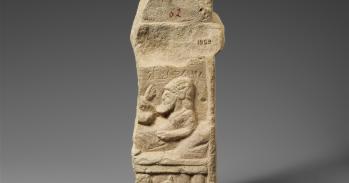
For those at the heart of this week's Royal Wedding, the big day will be full of stress and worry. But that's nothing compared with the experiences of Augusta of Saxony-Gotha, daughter in law of George II. A book by a Cambridge historian draws on new sources to reveal what happened.
For those at the heart of this week's Royal Wedding, the big day will be full of stress and worry. But that's nothing compared with the experiences of Augusta of Saxony-Gotha, daughter in law of George II. A book by a Cambridge historian draws on new sources to reveal what happened.
Her parents had told her that there would be no need to learn English as they assumed that after twenty years of rule by German princes, everyone in Britain would now be speaking German.
Every bride knows how complicated the arrangements for weddings can be: will the right flowers turn up? Will the car be on time? Those marrying into the royal family have a particular set of pressures to consider. Media attention focuses on the smallest of details and familial relationships are inevitably put under strain.
And while the spotlight will fall on Kate Middleton this Friday, she is not the first royal bride to negotiate a complicated set of rules and customs in the run up to her big day. However, she will be hoping for a more peaceful married life than some of her predecessors.
A new biography of George II by Cambridge University historian Andrew C. Thompson sheds new light on his reign, including his complicated family and private life – and the marriage of his son, Prince Frederick to Augusta of Saxony-Gotha.
The book includes groundbreaking research and makes use for the first time of material in German archives to uncover the rich and varied nature of George II’s public and private life.
At the end of April 1736, Augusta of Saxony-Gotha arrived in London to marry Frederick, Prince of Wales, eldest son of George II. Augusta and Frederick did not enjoy the luxury of a long courtship – Augusta had met Frederick’s father on one of George II’s visits to Hanover and this was sufficient to seal the deal.
She had been chosen because the provisions of the Act of Settlement (1701) made it imperative for members of the royal family to marry Protestants to retain their inheritance rights. George II’s relations with some of the major protestant powers, like Prussia, were strained and therefore brides had to be sought from lesser German princely families.
Her first meeting with her future husband was a few days before the wedding. Augusta found herself in a foreign country, knowing virtually nobody and with little idea of what to expect. Her parents had told her that there would be no need to learn English as they assumed that after twenty years of rule by German princes, everyone in Britain would now be speaking German.
Frederick’s sisters were irritated when the Prince of Wales tried to alter seating arrangements for family meals to give his future bride precedence over them.
The wedding itself took place in the Chapel Royal in St James’s palace and featured a new work composed for the occasion by the royal family’s favourite composer, George Frederick Handel. Prints of the ceremony were produced and circulated widely – commemorative memorabilia is nothing new. Augusta, however, had little say in the decoration of the venue. Just as this year, Easter was very late in 1736 so there was little time between Easter services on 25 April and the wedding on 27 April to do much to the Chapel Royal.
275 years after Augusta’s marriage, Kate Middleton faces similar difficulties in acclimatising to a new role. She, at least, has had the chance to get to know her future husband in advance. Augusta’s marriage was not for love but for politics.
Her major task was to help perpetuate the royal line by providing an heir. A son, the future George III, was born in 1738 but by this time, Augusta found herself in the middle of a bitter argument between her husband and father-in-law.
Unhappy with both his uncertain political role and lack of financial means, Frederick had quarrelled with his father and had been banned from attending court. Much of Augusta’s early married life was spent away from court in Kew and Cliveden. Frederick and Augusta tried to cultivate a popular image, spending time at fashionable spots such as Bath and supporting English trade. ‘Rule Britannia’ was first performed for the couple at Cliveden in 1740. After her husband’s death in 1751, Augusta became an important political player in her own right, guiding her eldest son, the future George III, through the trials and tribulations of court politics.
Augusta quickly learnt the value of presenting herself as a supporter of British culture. Her English improved quickly and was less accented than that of other members of the royal family. Her public image was that of the good mother and supportive wife and she was always meticulous about ensuring her clothes were made from native fabrics. Her status as a fashion trendsetter helped the British textile industry considerably.
Andrew Thompson’s new biography of George II will be published by Yale University Press in May 2011 It uses newly available diary evidence to reconstruct life at court in his final years. Careful reading of the letters and papers of those around the king enable Thompson to show the centrality of George for foreign political decision-making and shed new light on the importance of the king’s frequent visits to Hanover.
This work is licensed under a Creative Commons Licence. If you use this content on your site please link back to this page.





